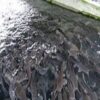- このトピックは空です。
- 投稿者投稿
- 3月 25, 2025 2:44 am #604804

When it comes to feeding catfish, understanding the optimal feeding times based on water temperature is crucial for both their health and growth. Catfish, like most aquatic species, have specific feeding habits that are heavily influenced by environmental factors, with water temperature playing a major role.
By adjusting feeding schedules according to the water temperature, fish farmers and hobbyists can ensure the catfish are fed at the right times, promoting optimal growth and minimizing waste.
1. How Water Temperature Affects Catfish Metabolism
Catfish are ectothermic, meaning their body temperature is regulated by the surrounding water. As water temperature rises, their metabolism speeds up, increasing their appetite. Conversely, colder water slows their metabolism, leading to a reduced need for food. Understanding this connection is essential to determine the best times to feed your catfish.
Warmer waters encourage active feeding, while cooler waters make feeding less necessary. Therefore, adjusting feeding times based on seasonal temperature changes can significantly improve feeding efficiency and overall catfish health.
2. Best Feeding Times in Warm Water
During warmer months, when water temperatures typically range from 70°F to 85°F, catfish are more active and have an increased metabolic rate. This is the prime time for feeding, as catfish require more food to sustain their energy levels. Feeding during the early morning or late afternoon can be particularly effective during warmer weather.
During these times, catfish are generally more likely to actively search for food, ensuring they consume it before it sinks or gets scattered by water currents. Feeding at these times also prevents the food from deteriorating in the sun’s heat, which could decrease its nutritional value.
3. Feeding Catfish In Cold Water
When water temperatures drop below 60°F, catfish become less active and their appetite significantly decreases. At these cooler temperatures, they may only feed a few times a week or may even enter a state of near dormancy during the winter months. In colder water, feeding times should be reduced to avoid overfeeding, as catfish will not metabolize the food effectively.
Feeding during the warmest parts of the day, typically in the afternoon when the sun has had time to warm the water slightly, can encourage catfish to feed. However, care should be taken to monitor the water temperature and adjust the feeding schedule accordingly.
4. Seasonal Considerations And Feeding Adjustments
As the seasons change, so does the water temperature, which means the optimal feeding times for catfish will also vary. In the spring and fall, when water temperatures fluctuate between cool and warm, it’s important to monitor the weather patterns and adjust feeding schedules to match. In the spring, when temperatures begin to rise, catfish will gradually increase their feeding behavior.
As temperatures drop in the fall, their activity slows, and feeding should become less frequent. Being aware of these seasonal shifts ensures you can align your feeding schedule with the catfish’s natural rhythms, promoting healthier growth and minimizing waste.
5. How To Monitor And Adjust Feeding Schedules
To achieve the optimal feeding times for catfish, it’s important to regularly monitor both the water temperature and the fish’s behavior. Using a thermometer to track water temperatures will help you pinpoint the best times to feed. Additionally, observing the catfish’s activity levels can give you clues about their hunger and feeding readiness.
If you notice that they’re less active and aren’t responding to food, it’s a sign that the water may be too cold for them to be hungry. Regular adjustments based on temperature changes and catfish behavior will help you fine-tune the feeding schedule.
In conclusion, understanding the optimal feeding times for catfish based on water temperature is essential for maintaining their health and maximizing their growth potential. By aligning feeding schedules with water temperature fluctuations, whether in warmer or cooler waters, you can ensure that your catfish are fed at the most appropriate times, encouraging better digestion and growth.
Whether you’re farming catfish or keeping them in a home aquarium, paying attention to water temperature will help you provide a healthier and more sustainable environment for your fish.
Read Also: Fueling Growth: What Can Igive my Catfish to Grow Faster?
- 投稿者投稿
- このトピックに返信するにはログインが必要です。






